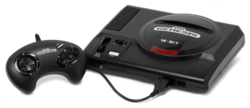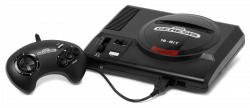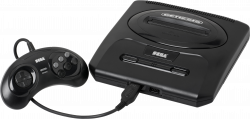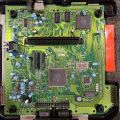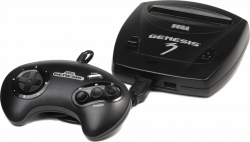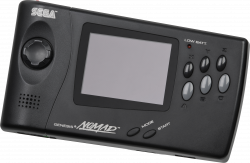Genesis:Buying Guide
Standalone Models
Model 1 (1988-1993)
- Rectangular in shape with a circular area surrounding the cartridge port
- Stereo audio is only available from the front headphone jack
- Outputs composite video, RGB and mono audio from a full-size 8-pin DIN connector
- French models only output RGB
- Power input is a 5.5 x 2.1 mm barrel jack with tip negative polarity
- All except French, Japanese and Korean models have RF output
- Asian, Japanese and Korean models have a cartridge lock mechanism
- Board revisions up to the VA6.5 have a 9-pin EXT port on the rear, which was only used in Japan for the Mega Modem add-on
- However, the EXT port is present in all Japanese models
- Power LED area is colored white on PAL models and red on all others
- "16-BIT" text is large and painted gold on Asian, Japanese and Korean models, small and silver on Brazilian and US models, and small and gold on PAL models
- Korean models were sold by (and later manufactured entirely by) Samsung as South Korea had heavy restrictions on Japanese consumer goods at the time
- Earlier models have "blurbs" silkscreened on the trim piece around the cartridge port area
- "AV Intelligent Terminal" and "High Grade Multipurpose Use" on Asian, Japanese and Korean models
- "High Definition Graphics" on Brazilian and North American models
- "High Definition Graphics - Stereo Sound" on PAL models
- Models with TMSS will have a bottom label listing various patent numbers
- In addition, US models with TMSS have the FCC ID "FJ8USASEGA"
- VA0 through VA2 board revisions have some audio distortion through the headphone jack as the preamp is slightly overdriven on these models. It can be corrected by substituting several capacitor and resistor values on the underside of the board.
- VA0 through VA4 board revisions have subpar composite video which has "rainbow banding" across the entire screen. This is due to the video circuitry in these models and is not because of bad capacitors, as is often repeated across the internet.
- VA3 through VA6.5 revisions require the least amount of work to get good quality audio and are fairly easy to find. Consoles without TMSS (VA3 through VA5) are generally favored as they have better game compatibility and boot straight into the game, but consoles with TMSS (VA6, VA6.5 and VA6.8) can still provide a good experience.
- If you are comfortable with soldering, the VA0 through VA2 models can be easily modified to improve their audio quality, and the audio on VA7 models can be improved with a Triple Bypass or Mega Amp board.
Sega produced many revisions of the model 1, typically to either reduce production costs by consolidating chips or to correct flaws from previous revisions.
Board Revisions
| Revision Name | Date Range | Regions | TMSS | EXT Port | Notes |
|---|---|---|---|---|---|
| "VA0" | 1988 | Japan | No | Yes | Has an internal daughterboard that corrects the EDCLK signal. The headphone jack slider cap can be easily pulled off. The "VA0" name is not official, but is used to refer to this board in keeping with Sega's typical revision naming practices. |
| VA1 | 1989 | Japan | No | Yes | Has the 315-5339 EDCLK generator chip instead of the daughterboard featured on the VA0. |
| VA2 | 1989 | Japan, North America | No | Yes | First revision for North America. Nearly identical to the VA1 but changes out the 315-5339 with the 315-5345 chip. |
| VA3 | 1989-1991 | Brazil and North America | No | Yes | First revision for Brazil. The 315-5308 and 315-5345 chips from the previous revision are combined into the 315-5364 I/O chip. Headphone preamp is no longer overdriven but has some low pass filtering added, making the audio slightly muffled. Video circuitry remains unchanged. |
| VA4 | 1989-1991 | Japan, Korea and PAL regions | No | Yes | First revision for PAL regions. Nearly identical to the VA3. PAL models with this board have the silkscreened text "High Definition Graphics - Stereo Sound" above the cartridge port. Video circuitry remains unchanged for Japanese models. |
| VA5 | 1990-1991 | Asia and Japan | No | Yes | Consolidates the 315-5309 and 315-5364 chips into one I/O chip (315-5402). Has slightly improved video circuitry but audio quality remains the same. |
| VA6 | 1991-1992 | Asia, Brazil, Japan and North America | Yes | Yes | Identical to the VA5 but has an I/O chip with TMSS (TradeMark Security System) functionality, which adds the "Produced By or Under License from Sega Enterprises, Ltd" screen at boot. Certain unlicensed games cannot be played beginning with this revision due to TMSS. Later Asian and Japanese VA6s lack the "AV Intelligent Terminal" blurb on the cartridge port area "ring". This is the most common version of the US model 1 that has the "High Definition Graphics" text on the top shell. |
| VA6.5 | 1992-1993 | North America and PAL regions | Yes | No | Identical to the VA6 but lacks the EXT port, and the rear panel has a large blank area where it once was. The "High Definition Graphics" blurb on all models has been removed, and on most VA6.5s, the colored part of the "ring" surrounding the power LED is a separate piece and not painted on. The VA6.5 name originates from Sega service manuals and is not denoted on the board itself. This is the most common version of the PAL model 1. |
| VA6.8 | 1992 | PAL regions | Yes | No | Almost identical to the VA6.5 but the video circuitry has been completely altered, as it uses a surface mount Fujitsu MB3514 video encoder instead of a through-hole Sony CXA1145. Seemingly very rare as few have been spotted. |
| VA7 | 1992-1993 | Japan and North America | Yes | Japan only | Complete internal redesign with most major chips consolidated into a custom ASIC, an increased use of surface mount chips and has a single 7805 voltage regulator instead of two. Has abysmal audio quality due to poor component choices in the audio circuitry, but can be corrected by modifications such as the Triple Bypass. On North American models, the rear ports have been shifted towards the center, making this model easily identifiable at a glance. Japanese VA7s still have the EXT port. Japanese models also have patent numbers embossed into the bottom shell as opposed to having them on a label like VA6s. |
Model 2 (1993-1998)
- Square in shape with a centered cartridge port
- No headphone jack
- Outputs composite video, RGB, mono audio and stereo audio via a 9-pin mini-DIN connector
- Power jack has been changed to an EIAJ-03 barrel jack (4.75 x 1.7 mm) with tip positive polarity
- Brazilian models are the only ones with internal RF output, all others use an external RF modulator
- Later Brazilian models also have an internal power supply with input voltage switchable between 110 and 220V
- Asian and Japanese models use a slide switch for power like the model 1, all others use a push button switch
- These models also lack a power LED
- As with the model 1, Samsung manufactured and sold the model 2 in South Korea due to that country's import restrictions
- VA0 through VA2.3 boards extend the entire width of the console, while the VA3 and VA4 only extend 3/4ths of the way. This is the easiest way to determine if a model 2 will have good audio quality or not.
- VA0 through VA1.8 revisions have terrible audio quality, and depending on the video encoder chip used, can have poor composite video as well. These are not recommended in stock form.
- For more information about the video encoder chips used in Genesis/Mega Drive consoles, check out this guide.
- To improve the audio quality on these models, a Triple Bypass board can be installed or some components can be changed out on the motherboard.
- Getting a VA4 is the only surefire way to have a model 2 with good composite video and audio. These are also some of the hardest to find as they were produced towards the end of the Genesis/Mega Drive's life.
- The power jack can often develop broken solder joints, preventing the console from powering on reliably, if at all. This is the most common problem with the model 2 and is easily fixed by reflowing the solder joints in question.
- Bootlegs of the Asian Mega Drive 2 are rampant on online marketplaces such as eBay, typically originating from eastern Europe. These are of very poor quality and should be avoided.
- This was the last version of the Genesis/Mega Drive hardware released in most parts of the world.
Board Revisions
| Revision Name | Date Range | Regions | Notes |
|---|---|---|---|
| VA0 | 1993 | All Regions | Basically a condensed VA7 model 1 using much of the same components. |
| VA1 | 1993-1994 | All Regions | Similar to the VA0 but only uses a single RAM chip each for main RAM and video RAM. Some changes were made to resistors in the audio circuitry in an attempt to reduce audio distortion. |
| VA1.8 | 1994-1996 | Asia, North America and PAL regions | Almost totally identical to the VA1, but some have extra wires going from the power jack's solder joints to extra solder pads on the board. |
| VA2 | 1994-1996 | North America | Uses a different main ASIC (315-5786) manufactured by Toshiba which does not have an FM chip core. These instead have a discrete YM2612 FM chip like most model 1s. However, the audio quality is not the same as most model 1s and these also have very quiet PSG audio. VA2s have a small "bodge" board which is wired at several points throughout the main board. |
| VA2.3 | 1995-1996 | North America | Similar to the VA2 but without the bodge board. Some of these have an ASIC with a buggy VDP core (315-5685), which causes odd graphical errors and ghosting as seen in the color bar test of the 240p Test Suite. |
| VA3 | 1994-1996 | North America | The first of the short board revisions. Has decent audio quality but video quality varies depending on the video encoder used. This board also has some compatibility issues with the VA0 revision of the 32X. |
| VA4 | 1996-1998 | Asia, North America and PAL regions | This is the first Genesis/Mega Drive to use a GOAC (Genesis On A Chip) ASIC, which combines all the main chips into one. North American VA4s can be discerned by small cutouts in the bottom RF shield, which are visible through the bottom vents. This distinction is irrelevant in Asian or PAL units since the VA4 was the only short board released in those regions. Composite video quality is decent and audio quality is slightly better compared to the VA3. Some US VA4s were sold by licensee Majesco. These can be determined by their different part number (MK-1451) and a white bottom label. |
Genesis 3 (1998-1999)
- Released by Majesco, but designed and engineered by Sega themselves
- The smallest of all Genesis/Mega Drive variants
- All were assembled in Mexico with PCBs being manufactured in Korea
- Uses the same AV and power connectors as the model 2, which are now on the left-hand side instead of the rear
- All Genesis 3 consoles output RGB in addition to composite video
- Has a wider cartridge slot which can accommodate most Japanese Mega Drive games
- Note that only Japanese Mega Drive games which don't check for region will work without modification. Japanese games made by Sunsoft will not fit.
- Only has mono audio, which is duplicated on the left audio pin of the AV connector.
- Stereo audio can be restored by a Triple Bypass modification
- Is totally incompatible with the Sega CD due to not having an expansion port, and is also incompatible with the 32X, Game Genie and Power Base Converter
- There are only two board revisions, the VA1 and VA2. These can only be determined without a teardown by closely looking at the traces near the cartridge port. Unlike the model 1 and model 2, the serial number is an unreliable method for determining board revision
- The VA1 is largely similar to the VA4 model 2 and uses the same GOAC. It is the only Genesis 3 which can be modified for 32X or Master System support. If you are looking to acquire a Genesis 3, make it this revision if possible.
- The VA2 uses a different GOAC and cannot be modified for 32X or Master System support at all. Only Game Genie and Virtua Racing compatibility fixes can be performed on this revision.
- In addition, the VA2 fixes a TAS instruction in the 68000 CPU, which actually breaks compatibility with the game Gargoyles as it exploited this flaw.
Handhelds
Mega Jet (1993-1994, Japan)
The Mega Jet is a semi-portable console initially made available in 1993 on certain Japan Air Lines flights and on March 10, 1994 to the general public in Japan only. It is essentially a VA3 revision model 2 condensed into a handheld form with a built-in 6-button controller, although it lacks a built-in screen or the ability to accept batteries, basically making it akin to a "plug & play" controller with a cartridge slot. Curiously, the Mega Jet has a fully wired cartridge port, allowing it to support Master System games and passthrough audio from a flash cart such as a Mega Everdrive Pro or Mega SD. Although the 32X will fit into the cartridge port and can function on the Mega Jet, it does not leave enough room for the necessary video jumper cable to be connected.
Genesis Nomad (1995, North America)
A natural evolution of the Mega Jet, the Genesis Nomad (though usually referred to as simply the "Nomad") was released in late 1995 as the first handheld game system since the NEC TurboExpress to play the same games as a home console. It was only released in North America. Designed by both Sega of Japan and Sega of America, the Nomad is compatible with the vast majority of the Genesis library, although it does not support SMS, 32X or Sega CD games due to not having an expansion port nor the required signals present on the cartridge port. The Nomad is a very bulky system, made even bulkier by the fact that it does not have an internal battery compartment; batteries are inserted into a separate pack which clips onto the back of the Nomad, making it very unwieldy to carry around.
Typical for color handhelds of the time, the Nomad's battery life is fairly poor as its six AA batteries can be depleted in just 2-4 hours. Screen modifications exist which replace the original fluorescent-backlit screen with a more modern panel, greatly improving both battery life and visual clarity. Like the Mega Jet, the Nomad can be connected to a TV, featuring the same mini-DIN connector as the model 2 Genesis and a controller port for a second player. However, the built-in screen is still active so use of an AC adapter is recommended in this scenario. Modifications can also be performed to restore SMS backwards compatibility and external audio for flash carts such as the Mega Everdrive Pro and Mega SD, allowing the Nomad to play Sega CD games. 32X support is greatly hampered by the fact that the 32X blocks the AV out.
All Nomad systems were built in Taiwan and do not have any revisions unlike most Sega hardware.
Although it received some praise from critics, the Nomad was a slow seller due to its high price and the fact that Sega did not do much to market the system, as they were transitioning from the Genesis to the new 32-bit Saturn.
CD Combo Consoles
Wondermega (1992, Japan)
Perhaps the most exorbitant of all Mega Drive consoles, the Wondermega is the first console to combine both a Mega Drive and a Mega CD in a single unit. A Japan-only release, the Wondermega was released in April 1992 under both the Sega and Victor (JVC) brands, with the Victor model coming first by a few weeks. In addition to playing both Mega Drive and Mega CD games, the Wondermega is loaded with features such as S-video out, MIDI out, two microphone inputs for karaoke, and a DSP for audio effects. To add to the opulence, the top-loading disc door is motorized and can automatically open or close through the controller. Two green light strips are also on each side of the disc area.
The Wondermega was also the first Mega Drive variant to use the FC1004 ASIC, which would later be used in the VA7 model 1 and most model 2 consoles.
Both the Sega and Victor models are identical with only very minor cosmetic differences, mainly limited to the colors of the power and reset buttons and the trim piece on the disc door. The Sega model also retailed for a slightly lower price (79,800 yen vs. 82,800 yen) than the Victor model. Due to their very high prices, both Wondermega models sold in limited numbers and are now highly sought after.
Wondermega M2/X'Eye (1993-1994, Japan/North America)
In 1993, Victor/JVC introduced a completely redesigned Wondermega, known as the Wondermega M2 (model number RG-M2). This new Wondermega featured a smaller, sleeker case and came packaged with a wireless infrared 6-button controller which could also double as a basic TV remote. This controller could also turn on the console remotely and had a controller port for a second player, not unlike 3DO controllers. However, a number of cost-cutting changes were made, including the removal of the DSP audio effects, the motorized disc door and MIDI out. The Wondermega M2 could also still use wired controllers, although the controller ports were moved to the rear of the console to leave room for the infrared receiver at the front.
Much like its closest competitor, the PC Engine Duo, the Wondermega M2 also suffers from leaky surface-mount capacitors and any M2 unit should be fully recapped in order to keep it functioning.
During the spring of 1994, JVC brought over the Wondermega M2 to North America as the JVC X'Eye, which retailed for US$499.95 and came bundled with a variety of CD software, including Compton's Interactive Encyclopedia, Prize Fighter, and a karaoke CD. Further cost reductions were made with the X'Eye, with both the S-video output and infrared receiver being removed, as well as one of the microphone inputs and the volume control for the headphone out. The controller ports were relocated to the front of the console to compensate for the removed IR receiver, and the power button was also changed from the momentary type used in the M2 to a push button switch like in a model 2 Genesis. A JVC-branded version of the standard Genesis 3-button controller was also bundled with the console.
Most X'Eyes also feature the same 9-pin mini-DIN connector found in the model 2 Genesis, meaning that a 32X can be connected to these X'Eyes. However, the 32X blocks the disc door, so it must be removed every time the disc door is opened. For 32X owners, JVC offered a service where the console was given a modified disc door, allowing it to fully open with a connected 32X. This service was also made available to Wondermega M2 owners in Japan for a 5,000 yen fee until 2013.
CDX/Multi-Mega (1994, All Regions)
Released in 1994, the Sega Genesis CDX is a small console combining the Sega CD and Genesis/Mega Drive together, while also functioning as a portable CD player. Only some thousands of these were made, resulting in significant rarity. Video quality of these systems is quite good, but the sound is a bit mixed (too quiet, weak bass without headphones). FMV-heavy Sega CD games may freeze up on this system. It is compatible with the 32X and Power Base Converter despite its different physical form compared to standalone Genesis/Mega Drive consoles, and also features the same 9-pin mini-DIN video out as the model 2 with RGB output.
Unlike the JVC/Victor combination consoles, the CDX was also released in PAL regions, Asia and Brazil, where it was known as the Multi-Mega. Curiously, the CDX was not released in Japan by Sega themselves, but by the global language training company Linguaphone, who sold it as an educational tool and branded it as the Education Gear .
Aiwa Mega CD (1994, Japan)
One of the most unusual console variants ever released for any system, the Aiwa Mega CD (model number CSD-G1M) is a combination of a Mega Drive, Mega CD and boombox complete with CD player, cassette deck and radio tuner. Both the boombox and Mega Drive/Mega CD are separate components, presumably so that the boombox can be taken on the go to play music while the game hardware remains behind at home; the two are connected via a DB25 cable. The front of the "dock" has the cartridge port at the center with the two controller ports on each side of it. The rear features a DB25 connector for the docking cable and the same 9-pin mini-DIN found on the Mega Drive 2. Power is provided via the boombox's power supply. Although not designed for them, the CSD-G1M is compatible with the 32X and even Master System adapters, although care must be taken due to the cartridge port being mounted at the front.
The Aiwa Mega CD did not sell very well and remains a sought-after collector's item, mostly due to its rarity but also for the sheer novelty of having a Mega Drive with a boombox.
PC Combo Consoles
TeraDrive (1991, Japan)
Introduced in May 1991 as a collaboration between IBM and Sega, the TeraDrive is a combination of a Mega Drive and an IBM PC. The system is a slim desktop PC with the Mega Drive cartridge slot, 3.5" floppy drive(s), headphone jack with volume control, Mega Drive controller ports and two PS/2 ports at the front panel. At the rear are a 9-pin RS232 serial port, DB25 parallel port, RGB out, composite video out with stereo audio, a Mega Drive EXT port and space for a single ISA expansion card. The TeraDrive was available in three configurations; the Model 1 featured 640 KB of RAM and a single floppy drive, the Model 2 with 1 MB RAM and two floppy drives, and the Model 3 with 2.5 MB RAM along with a single floppy drive and a 30 MB hard drive. While the TeraDrive has the Mega Drive's expansion port, it is positioned on the top of the unit, preventing the use of a Mega CD add-on.
However, both the Mega Drive and PC-compatibles were not popular in Japan during this time, not helped by the fact that the TeraDrive had a fairly weak 286 CPU while most PCs had moved on to 386 or 486 processors. As a result, the TeraDrive sold very poorly and it has since become a very rare collector's item.
Amstrad Mega PC (1993, Europe and Australia)
Much like the TeraDrive before it, the Amstrad Mega PC is a combination between an IBM-compatible PC and a Mega Drive. It was only released in Europe and Australia during 1993 and also shipped with a dual 15/31 kHz monitor. Unlike the TeraDrive, the Mega PC featured a 386 processor and had the Mega Drive hardware on a separate ISA card (this was integrated in the TeraDrive's motherboard). Also unlike the TeraDrive, the Mega Drive portion could not interact in any way with the PC side, and a sliding door on the front covers the Mega Drive cartridge slot or 3.5" floppy drive depending on which section is used.
Although it saw somewhat greater success than the TeraDrive, the Mega PC still sold in fairly small quantities, possibly due to its high price and the fact that it used a 386 while most PCs were using 486 CPUs. Amstrad announced a revised model with a 486 called the "Mega PC Plus" to rectify this, but it was never released.
References
https://segaretro.org/Sega_Multi-Mega (CDX discontinue date info)
https://en.wikipedia.org/wiki/Sega_Genesis
https://www.retrorgb.com/genesisversions.html
https://gametrog.com/sega-cdx-information-specs/
https://segaretro.org/Sega_Mega_Drive/Hardware_revisions (board pics)
https://gametrog.com/sega-genesis-1-2-3-information-specs/
https://retroconsoles.fandom.com/wiki/Sega_Mega_Drive/Genesis
https://www.sega-16.com/forum/showthread.php?27397-VA2-Preamp-fix
https://www.sega-16.com/forum/showthread.php?22892-Sega-Genesis-Mega-Drive-Manufacture-Date-Registry (other manuf dates)
https://www.sega-16.com/forum/showthread.php?7796-GUIDE-Telling-apart-good-Genesis-1s-and-Genesis-2s-from-bad-ones (invaluable info)
https://medium.com/rgb-inside/comparing-native-rgb-video-quality-of-different-models-of-mega-drive-and-sega-genesis-english-e3d3703270ba (video output info + other variants)
https://www.reddit.com/r/SEGAGENESIS/comments/j6qg7k/sega_genesis_models_1_2_3_sound_question/
https://www.reddit.com/r/SEGAGENESIS/comments/biueke/gensis_va2mega_drive_va02_preamp_fix/
